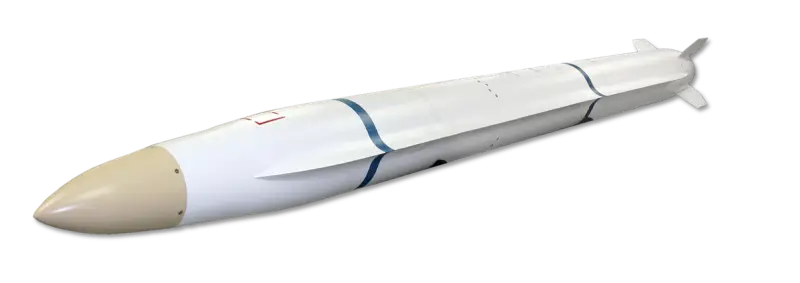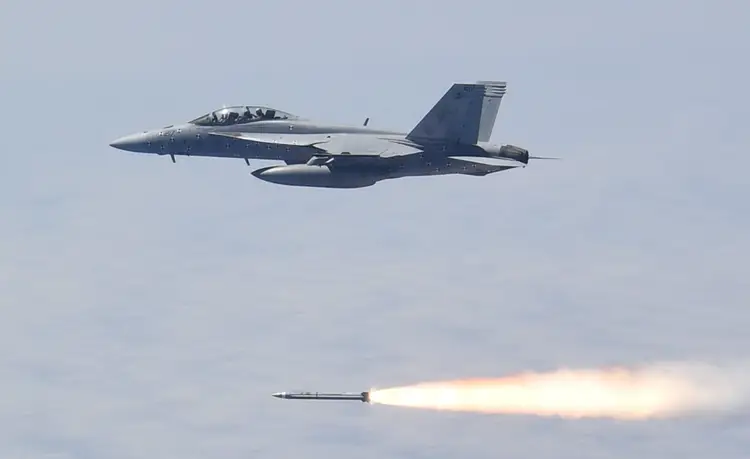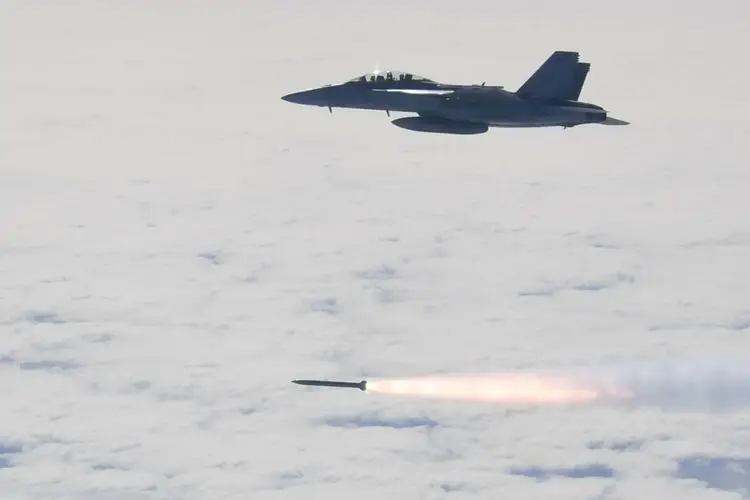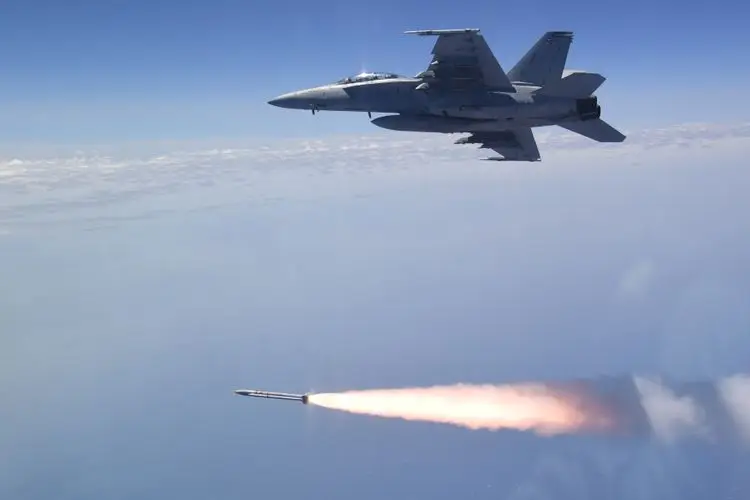The AGM-88G AARGM-ER anti-radar missile is approaching adoption

An AGM-88G missile under the wing of an F/A-18E aircraft, May 2023.
Since the mid-eighties, tactical aviation The US uses the AGM-88 HARM anti-radar missile. Over the past time, this product has undergone several successive upgrades aimed at improving all the main tactical and technical characteristics. Right now, work is underway on another modification of the missile under the designation AGM-88G AARGM-ER. This version of the product has almost completed testing and will be used by the troops by the end of the current financial year.
New generation
At the beginning of the 88s, the Pentagon came to the conclusion that it was necessary to create the next modification of the existing anti-radar missile. The future product received the index AGM-2003E and its own name Advanced Anti-Radiation Guided Missile (AARGM). The development of the rocket in XNUMX was entrusted to Orbital ATK.
The project involved the replacement of all key components of the missile - the homing head, autopilot and engine, which affected the development time. The AARGM product entered service only in 2012. Its first customers were the US Navy and Marine Corps, while the Air Force decided to continue using the AGM-88 of previous versions. Then the first export contracts appeared.
In the mid-88s, the Navy formed a tactical and technical specification for the next modernization of the AGM-2016E missile, which included increasing the flight range. This project was given the letter “G” and the name Advanced Anti-Radiation Guided Missile Extended Range (AARGM-ER). Development of the updated missile was launched as part of the FY XNUMX military budget. As always, a competition was announced, one of the participants of which was the Orbital company.
The AGM-88G project involved rebuilding the rocket, as well as replacing the standard solid propellant engine with a more powerful product, which would provide a new level of flight performance. At the same time, key devices should have been preserved. This circumstance to some extent accelerated and simplified the development - Orbital ATK (now part of Northrop Grumman Innovation Systems) presented its project in September 2016. In January 2018, its project was called the most successful and a contract was issued for its further development.

General view of the AARGM-ER missile
Initially, the customers of the AARGM-ER product were the US Navy and Marine Corps. Later, at the stage of signing a full development contract, the Air Force joined them. Together, they formed the final requirements for the future rocket, and also determined the range of its promising carriers. Subsequently, the requirements and plans were adjusted in one way or another.
At the test stage
Despite the relative simplicity of the technical specifications, the development of the AARGM-ER project took about three years. Only in 2021 did the performing company move on to manufacturing a pilot batch of missiles for future testing. At that time, it was assumed that all the following activities would take no more than a couple of years, and during FY2023. new weapon will enter combat units of naval aviation and reach initial operational readiness. In parallel, it will be deployed in other branches of the military.
Tests of the AGM-88G missile were carried out at the Point Mugu naval range in the state. California. Serial F/A-18E/F fighter-bombers were used as an air platform for experimental products. Ground targets were also used to simulate the operation of radars and other systems of a potential enemy.
Flight testing of the new product began in July 2021. The first launch of the rocket for a training target was successful. The next drops took place in January and July 2022. These events tested the behavior of the rocket in the air and the operation of its systems, as well as aircraft instruments. During this testing phase, in September 2021, Northrop Grumman received permission to prepare for mass production.
In November 2022, with the participation of the Navy, they carried out the fourth launch, in which they tested the modified rocket equipment. Two more such tests took place in April and July 2023. It was reported that in all cases the missiles coped with the assigned tasks and confirmed the calculated characteristics.

First launch of the AGM-88G rocket, July 2021
However, due to various modifications and improvements in the design, the tests were noticeably delayed, and they could not be completed within the previously established deadlines. As a result, the start of low-rate production and initial operational capability has moved forward from FY2023. for a later date.
Actual plans
On February 1, the Pentagon's Director of Operational Test and Evaluation (DOT&E) published its annual review of promising projects and developments being implemented in the interests of the armed forces. This time, the report summarized the results of the recently concluded FY2023. One of the sections of this document is devoted to the AGM-88G AARGM-ER program, its recent successes and plans for the near future.
According to the DOT&E report, by the end of last fiscal year the Pentagon and the contractor had completed the bulk of the testing and are now preparing the missile for service. Production and deliveries to naval combat units have begun. For Q1 FY2024 (last months of the 2023 calendar year) the first test launch was planned as part of the deployment to the troops and the achievement of initial operational readiness.
Actually, initial readiness will be achieved in the 3rd quarter of the current financial year, i.e. by the middle of the calendar year. In this case, we are talking about only one or several divisions. After this, the Navy will have to bring the first squadrons to full operational readiness and carry out similar re-equipment of other units and formations. All this may take several years, but exact dates have not yet been announced.
The Navy will be the first to receive the new AGM-88G missile. Then deliveries will begin to air force and military units. The start of export sales is also expected. Based on the results of some of the tests carried out, in 2023 Australia, the Netherlands and Finland showed interest in the new weapon. Negotiations are already underway and contracts are being prepared. In addition, the United States is waiting for orders from other countries wishing to update their existing arsenals.

Test launch in January 2022
Extended range missile
The main goal of the AARGM-ER program, as its name implies, was to create a new modification of an existing anti-radar missile with increased range characteristics. In addition, they planned to improve the on-board electronics, although without fundamental innovations, and also to expand the range of possible carriers, taking into account the development trends of combat aviation of the Air Force, Navy and Marine Corps.
A new airframe was developed for the AGM-88G product. A large elongation cylindrical body with a pointed head fairing was used; on its sides there are thickening planes that create lift and replace the traditional wing. X-shaped rudders are placed in the tail. The total length of the rocket is 4,06 m, diameter - 292 mm, launch weight - 467 kg. For comparison, previous modifications of the AGM-88 had a length of 4,17 m with a diameter of 254 mm and weighed 361 kg.
More than half of the hull volume is dedicated to a new solid fuel engine with improved performance. With its help, the rocket should reach a speed of 2,5-3 M and fly to a distance of up to 300 km. The maximum range of previous missiles of the family did not exceed 140-150 km.
The electronics for the AGM-88G are actually borrowed from the previous product with the letter “E”, but modified using a modern element base. However, the functions and main characteristics remain the same. The missile is equipped with a passive radar seeker capable of tracking ground-based radiation sources. Protection against interference and loss of target signal is declared. The flight to the target area is carried out using satellite and inertial navigation.
The warhead was also borrowed from the serial AARGM. This is a high-explosive fragmentation product weighing 68 kg, designed to destroy unprotected targets. Such a warhead must effectively hit and destroy antenna devices and radar equipment cabins or other similar objects.

Tests November 2022
Commissioned by the US Navy, the AGM-88G AARGM-ER missile is primarily being integrated into the weapons system of the F/A-18E/F carrier-based fighter-bombers. It was with these aircraft that the rocket underwent recent tests. It is also planned to equip F-35C fighters.
It is proposed to expand the list of carrier platforms beyond fighter aircraft. Thus, since the beginning of last year, work has been underway to equip P-88 Poseidon patrol aircraft with the AGM-8G missile. A ground launcher is being developed.
The Marine Corps plans to use AARGM-ER products with the F-35B aircraft. It is curious that such missiles will only be transported on an external sling. Placement in internal cargo compartments is not possible due to the increased dimensions of the weapon.
The Air Force is planning to equip its F-16 and F-35A aircraft with the new missile. Unlike ILCs, they will not face restrictions and operational problems. It is assumed that foreign customers will use their missiles with the same platforms. It is also possible to integrate the AGM-88G into the weapons systems of other aircraft, incl. foreign development.
On the eve of rearmament
Thus, the AARGM-ER program successfully achieves its objectives and is gradually approaching its completion. Not all plans were completed on time, but the lag is not critical, and in general the situation does not give reason for pessimism.
According to the current schedule, over the next few months, the new AGM-88G anti-radar missile will reach the initial operational readiness stage in the first naval aviation squadrons. Then these events will continue in the form of rearmament of other units and formations of the Air Force and Marine Corps. The full-scale introduction of such missiles will take several more years.
Information